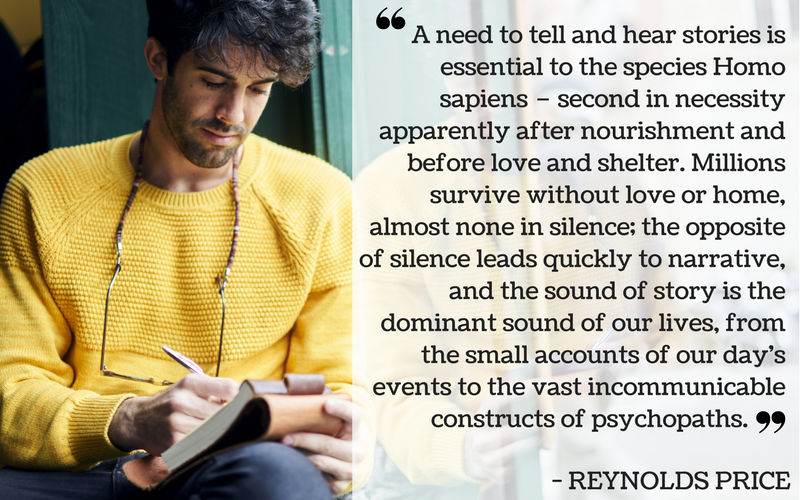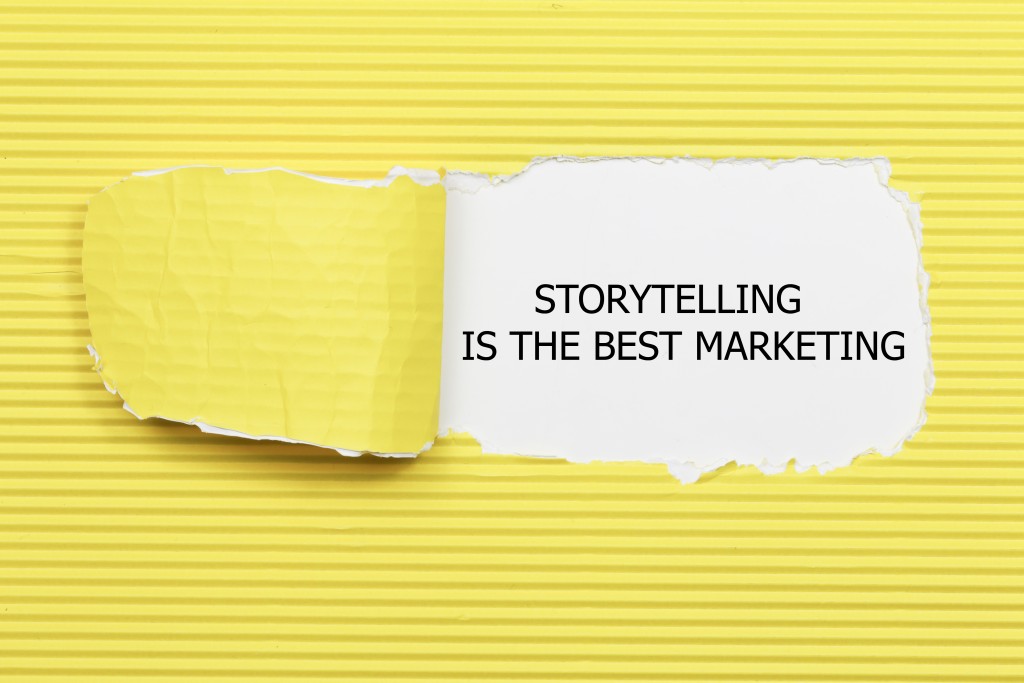May I ask you to kindly pause for a moment and consider the last brand you engaged with. What was it that drew you to that business? What made you decide to go ahead with a purchase or to subscribe to a service? Maybe it was purely for the sake of convenience, but for most thriving brands out there, you’ll notice that they’ve nailed the art of storytelling. Mankind has been sharing stories for literally generations upon generations. It’s a culture that has become deeply ingrained and totally intrinsic within our societies, and as such, it is something we inherently yearn after. In fact, the great American poet and novelist Edward Reynolds Price is renowned for the way he so eloquently described storytelling:  From the flickering fires of a gloomy cave to the pocket-sized devices we carry with us 24/7 Whilst storytelling certainly predates writing, these days it also comes in plenty of non-traditional formats that our Neanderthal ancestors would never have dreamed of. Digital avenues such as blogs, infographics, e-books, cheat sheets, live videos, definitive guides, articles, white papers, press releases and social media channels all provide a parade of platforms to spruik your story. Furthermore, the ubiquity of storytelling in the 21st century means that we tend to crave and expect stories more than ever; something that many businesses are latching onto and subsequently profiting from. This is where brand storytelling comes in – a chance for businesses to give themselves a personality in an atmosphere where so many big-name conglomerates remain grey and faceless. By giving your business a story, you plate up something your audience can relate to.
From the flickering fires of a gloomy cave to the pocket-sized devices we carry with us 24/7 Whilst storytelling certainly predates writing, these days it also comes in plenty of non-traditional formats that our Neanderthal ancestors would never have dreamed of. Digital avenues such as blogs, infographics, e-books, cheat sheets, live videos, definitive guides, articles, white papers, press releases and social media channels all provide a parade of platforms to spruik your story. Furthermore, the ubiquity of storytelling in the 21st century means that we tend to crave and expect stories more than ever; something that many businesses are latching onto and subsequently profiting from. This is where brand storytelling comes in – a chance for businesses to give themselves a personality in an atmosphere where so many big-name conglomerates remain grey and faceless. By giving your business a story, you plate up something your audience can relate to.
But what exactly is brand storytelling?
We’re all familiar with common fairy tales and mythology, but what does it mean to tell the story of your brand? Naturally, this deviates somewhat from other forms of storytelling. Yes, you might not have the creative licence granted by fictional narratives, but at the crux of it, the elements are all the same:
- Characters
- Setting
- Plot
- Conflict
- Resolution
- An audience
Thus, in brand storytelling, you ultimately share stories about your:
- Brand
- Products and solutions
- Customers
- Employees
To break it down a bit further, digital marketing expert Neil Patel states that key components of brand storytelling include:
- The reason your company came to be;
- What motivates you and your team to come to work each day;
- Offering your audience an inside look at your company.
At the end of the day, outsiders come to perceive your brand as a culmination of all the stories generated by your customers, your partners, your internal teams and the like. Inasmuch, an engaging, informative and positive story can potentially whizz your business to starry-eyed success.
Why is storytelling so important for businesses?
I’m going to say it straight: a brand devoid of a story is like a restaurant without tables and chairs. Sure, it might deliver on its products and services, but the customer isn’t treated to the experience he or she expects.  Simply put, storytelling is about differentiating yourself from your competitors. The reasons some brands seem to experience much higher success rates is not just a matter of smart business decisions: it also comes down to the story they are telling. Consider brands like Google – though a multi-national giant corporation, this iconic company has managed to create a personality for itself that its audiences enjoy engaging with. By tapping into key events and customising its banner each day of the year, Google’s penchant for storytelling remains central to its highly-esteemed status. On a smaller, local level, let’s look at Melbourne-based brand Go-To Skin Care. Pioneered by wordsmith Zoe Foster-Blake, this brand has curated a strong-as-nails brand voice that deeply resonates with its customers. From a consistent colour theme threaded through its Instagram presence to quirky packaging messages, Go-To shines amongst other skincare brands, successfully telling its story and engaging its audience.
Simply put, storytelling is about differentiating yourself from your competitors. The reasons some brands seem to experience much higher success rates is not just a matter of smart business decisions: it also comes down to the story they are telling. Consider brands like Google – though a multi-national giant corporation, this iconic company has managed to create a personality for itself that its audiences enjoy engaging with. By tapping into key events and customising its banner each day of the year, Google’s penchant for storytelling remains central to its highly-esteemed status. On a smaller, local level, let’s look at Melbourne-based brand Go-To Skin Care. Pioneered by wordsmith Zoe Foster-Blake, this brand has curated a strong-as-nails brand voice that deeply resonates with its customers. From a consistent colour theme threaded through its Instagram presence to quirky packaging messages, Go-To shines amongst other skincare brands, successfully telling its story and engaging its audience.
[caption id="attachment_5509" align="aligncenter" width="501"] Brand storytelling done right: Aussie skin care label Go-To has nailed the art of crafting and delivering its brand story.[/caption]
Brand storytelling done right: Aussie skin care label Go-To has nailed the art of crafting and delivering its brand story.[/caption]
How storytelling plays into the purchasing decision
You may not want to admit it or recognise it, but the way you paint your brand can have a huge impact on your customers. You might have an identical product offering to another company, but if you implement strategic and consistent storytelling, you have a much greater chance of winning over customers. In essence, effective brand storytelling achieves the following goals:
- Bridges an emotional connection with your audience;
- Identifies your company’s core values;
- Builds trust in the minds of your customers.
More than 90% of marketers hail digital content marketing as an integral business strategy According to Content Marketing Institute’s 7th Annual B2B Content Marketing Benchmarks, Budgets and Trends – North America, the vast majority of marketing specialists are devoted to content marketing strategies. Indeed, this area of marketing is shimmying ahead at a rapid rate, with brands increasingly realising the need to sharpen their reputations, situate themselves as thought leaders of their industry, and show their customers they have a personality. Of course, the very nature of content marketing revolves around storytelling. This is the arena for brands to show who they are, what they do, how they solve problems, and arguably most importantly, how they add value to and engage with their customers.  Customers are becoming increasingly reliant on researching a brand before making a purchase If the fact that almost every marketer these days is invested in storytelling hasn’t swayed you, perhaps the customer’s perspective will. Further research across the world indicates that these days, most consumers are privy to scoping out a business before committing to one. After all, with the prevalence of customer review platforms out there, it’s a cinch to quickly whip out your phone and dabble in a quick spot of research before deciding yay or nay on a brand. Consumers are also highly likely to follow a brand on social media channels so they can gauge a view of said brand before purchasing products or services with them. Just to cement this fact, the latest Instagram statistics highlighted that 70% of hashtags nowadays are branded, while 80% of Insta users follow at least one business on the platform. And, given recent trends, it’s safe to assume that these numbers are only likely to grow. What does a poor brand storytelling strategy look like? While we’ve established that brand storytelling should indeed be part of your business’s lifeblood, there can be a right way and a wrong way to go about it. Some businesses tend to get a little too enthusiastic and thrust themselves into the social and content channels with all sorts of material, resulting in a tangled mish-mash of messages. Let’s be clear – brand storytelling is not:
Customers are becoming increasingly reliant on researching a brand before making a purchase If the fact that almost every marketer these days is invested in storytelling hasn’t swayed you, perhaps the customer’s perspective will. Further research across the world indicates that these days, most consumers are privy to scoping out a business before committing to one. After all, with the prevalence of customer review platforms out there, it’s a cinch to quickly whip out your phone and dabble in a quick spot of research before deciding yay or nay on a brand. Consumers are also highly likely to follow a brand on social media channels so they can gauge a view of said brand before purchasing products or services with them. Just to cement this fact, the latest Instagram statistics highlighted that 70% of hashtags nowadays are branded, while 80% of Insta users follow at least one business on the platform. And, given recent trends, it’s safe to assume that these numbers are only likely to grow. What does a poor brand storytelling strategy look like? While we’ve established that brand storytelling should indeed be part of your business’s lifeblood, there can be a right way and a wrong way to go about it. Some businesses tend to get a little too enthusiastic and thrust themselves into the social and content channels with all sorts of material, resulting in a tangled mish-mash of messages. Let’s be clear – brand storytelling is not:
- Inconsistent
- Boring
- Last-minute
- Focused on stats and impressive results
- A mission statement
- A tagline
- Skewed to show only one aspect of your organisation
- ‘Me me me’
Rather, it’s about taking a thorough and considered approach that provides value to your audience, whether in the form of information, entertainment or both.  So, what’s your brand story? Coming up with your own brand story to tell requires you to sit down and stimulate those brain cells. Start by asking yourself the following four questions: 1. What are your goals? Before launching into it, you need to outline a strategy and clearly define your goals and objectives. Consider what you want to accomplish on social media – is it to build a bigger audience? Address customer enquiries? Identify trends? Drive leads? Each result will determine a different strategy, so take the time to plan accordingly. 2. What channels will you use? You also need to consider what channels you want to use. Far too often, businesses will eagerly create an account for a social platform only to abandon it after a month or two. Make sure you have the resources and energy to pour into each channel you sign up to as these are long-term strategies, not temporary fixtures to have a bit of fun with. 3. Who is your audience? Consider who you want to reach out to and what their background is. What messages will resonate with these people? Why should they care about what you have to say? Take the time to answer these questions, and make sure you are carefully crafting content that speaks to them. 4. What’s your content plan? Once you’ve established your audience and channels, develop a strong content plan that will deliver engaging and consistent material. Look ahead and draw up a content calendar – this could be weekly, quarterly, yearly, or a combination. Make sure you’re telling the right story at the right time by scheduling your stories and tailoring them to each channel. Key takeaways If you’re onboard the storytelling bandwagon, bravo – we salute you. We know it might seem like a bit of information overload, which is why we’ve parcelled everything up into this little bank of key takeaways:
So, what’s your brand story? Coming up with your own brand story to tell requires you to sit down and stimulate those brain cells. Start by asking yourself the following four questions: 1. What are your goals? Before launching into it, you need to outline a strategy and clearly define your goals and objectives. Consider what you want to accomplish on social media – is it to build a bigger audience? Address customer enquiries? Identify trends? Drive leads? Each result will determine a different strategy, so take the time to plan accordingly. 2. What channels will you use? You also need to consider what channels you want to use. Far too often, businesses will eagerly create an account for a social platform only to abandon it after a month or two. Make sure you have the resources and energy to pour into each channel you sign up to as these are long-term strategies, not temporary fixtures to have a bit of fun with. 3. Who is your audience? Consider who you want to reach out to and what their background is. What messages will resonate with these people? Why should they care about what you have to say? Take the time to answer these questions, and make sure you are carefully crafting content that speaks to them. 4. What’s your content plan? Once you’ve established your audience and channels, develop a strong content plan that will deliver engaging and consistent material. Look ahead and draw up a content calendar – this could be weekly, quarterly, yearly, or a combination. Make sure you’re telling the right story at the right time by scheduling your stories and tailoring them to each channel. Key takeaways If you’re onboard the storytelling bandwagon, bravo – we salute you. We know it might seem like a bit of information overload, which is why we’ve parcelled everything up into this little bank of key takeaways:
- Understand your audience on a deep level
- Focus on collaboration between written content and social media
- Have a strategy in place (and keep it documented!)
- Schedule when and how you are going to tell which part of your story
- Ensure everyone in your company is aware of your brand story




